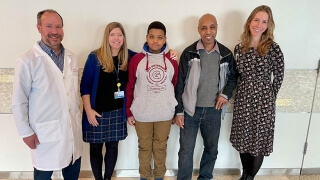PHILADELPHIA — A revolutionary new treatment could potentially be the precursor to a cure for deafness. An experimental gene therapy from the Children’s Hospital of Philadelphia (CHOP) has shown promising results in a patient with a rare genetic form of hearing loss, marking a significant advancement in this medical field. The best part of this is a young child is now able to hear his father’s voice for the very first time.
“Gene therapy for hearing loss is something that we physicians and scientists in the world of hearing loss have been working toward for over 20 years, and it is finally here,” says Dr. John A. Germiller, an attending surgeon and director of clinical research in the Division of Otolaryngology at CHOP and associate professor at Perelman School of Medicine at the University of Pennsylvania, in a media release.
“While the gene therapy we performed in our patient was to correct an abnormality in one, very rare gene, these studies may open the door for future use for some of the over 150 other genes that cause childhood hearing loss.”

Genetic abnormalities that cause hearing loss is a condition that affects approximately one in 500 newborns.
The treatment involves a unique procedure where copies of the normal OTOF gene are delivered directly into the inner ear. Doctors performed this on an 11-year-old patient born with OTOF-mediated hearing loss. The procedure, conducted on Oct. 4, 2023, used a minimally invasive method to insert a gene therapy solution into the cochlea, the inner ear’s auditory portion.
Remarkably, just four months after receiving the treatment in one ear, the patient experienced a significant improvement in hearing, transitioning from profound deafness to mild to moderate hearing loss. This change has enabled the child to hear sounds for the first time, including his father’s voice and everyday noises like passing cars.

Gene therapy for hearing loss functions by restoring the normal operation of sensory cells in the inner ear. These cells can then respond to sound and activate the auditory nerve, sending impulses to the brain. This is achieved by using a viral vector, a modified virus that safely transports the OTOF genes into the cochlea’s cells.
CHOP’s involvement in this pioneering treatment is part of the AK-OTOF-101 clinical trial, sponsored by Akouos, Inc., a subsidiary of Eli Lilly and Company. This trial is part of a global effort, with CHOP being one of the several clinical trial sites.
Dr. Germiller’s expertise in endoscopic round window surgery, developed over a decade ago for different cochlear procedures, played a crucial role in the successful delivery of this gene therapy.
“As more patients at different ages are treated with this gene therapy, researchers will learn more about the degree to which hearing is improved and whether that level of hearing can be sustained over many years,” notes Dr. Germiller. “What we have learned from following this patient’s progress will help direct our efforts toward helping as many patients as we can.”
The ongoing research and patient monitoring at CHOP will continue to inform and enhance treatment strategies for a wide range of patients with genetic hearing loss.
